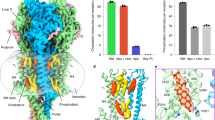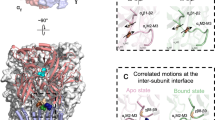Abstract
Skeletal muscles of adult mice and frogs were dissociated enzymatically and prepared for patch-clamping within less than 6 h. Outside-out patches were superfused with repetitive pulses of acetylcholine (ACh) with switching times of about 0.2 ms. Peak responses were reached within 1 ms. In mouse muscle the average channel conductance was 65 pS and the average open time 1 ms (20° C). Between 1 and 10 μM ACh, the peak responses increased proportional to the second to third power of the ACh concentration, and less steeply between 10 and 1000 μM ACh. The apparent K m of the dose-response curve was about 100 μM. After the peak, channel opening probability declined with time constants decreasing from about 1 s with 1 μM ACh to 15–50 ms with 1 mM ACh. After 100 ms desensitization the channel opening had decreased to less than 1/300 peak value. The rate of desensitization increased with rising temperature, with Q 10 values of 1.7–2.5 between 10 and 30° C. The desensitization characteristics of channels from frog muscle were similar to that from mice. With pulses of 100 μM ACh the channels opened with a probability of 0.55, the open probability declining with a time constant of about 60 ms and dropping to less than 0.001 after 300 ms. The results support the view that three binding steps of ACh are necessary for opening of the channel. Desensitization in the presence of high ACh concentrations is slower than the decay of synaptic currents.
Similar content being viewed by others
References
Adams PR (1987) Transmitter action at endplate membrane. In: Salpeter MM (ed) The vertebrate neuromuscular junction (Neurology and neurobiology). Liss, New York, pp 317–359
Albuquerque EX, Deshpande SS, Aracava Y, Alkondon M, Daly JW (1986) A possible involvement of cyclic AMP in the expression of desensitization of the nicotinic acetylcholine receptor. FEBS Lett 199:113–120
Allen CN, Akaike A, Albuquerque EX (1984) The frog interosseal muscle fiber as a new model for patch clamp studies of chemosensitive- and voltage-sensitive ion channels: actions of acetylcholine and batrachotoxin. J Physiol (Paris) 79:338–343
Bekkers JM (1986) Studies on single ion channels: non-stationary sodium current fluctuations in squid axon and patch clamp analysis of acetylcholine channels in cultured rat skeletal muscle. Ph.D. Thesis, Cambridge University
Brett RS, Dilger JP, Adams PR, Lancaster B (1986) A method for the rapid exchange of solutions bathing excised membrane patches. Biophys J 50:987–992
Cachelin AB, Colquhoun D (1989) Desensitization of the acetylcholine receptor of frog end-plates measured in a vaseline-gap voltage clamp. J Physiol (Lond) 415:159–188
Cohen J, Strnad NP (1987) Permeability control and desensitization by nicotinic acetylcholine receptors. In: Konijn TM, Haaster PJ van, Starre H van der, Wel H van der, Houslay MD (eds) Molecular mechanisms of desensitization to signal molecules. Nato ASI Series, vol H6. Springer, Berlin Heidelberg New York, pp 257–273
Colquhoun D, Ogden DC (1988) Activation of ion channels in the frog end-plate by high concentrations of acetylcholine. J Physiol (Lond) 395:131–159
Colquhoun D, Sakmann B (1985) Fast events in single-channel currents activated by acetylcholine and its analogues at the frog muscle end-plate. J Physiol (Lond) 369:501–557
Connor EA, Fiekers JF, Neel DS, Parsons RL, Schnitzler RM (1984) Comparison of cholinergic activation and desensitization at snake twitch and slow muscle end-plates. J Physiol (Lond) 351:657–674
Cox RN, Kaldany RJ, DiPaola M, Karlin A (1985) Time-resolved photolabeling by quinacrine azide of a noncompetitive inhibitor site of the nicotinic acetylcholine receptor in a transient, agonist-induced state. J Biol Chem 260:7186–7193
Datyner NB, Gage PW (1980) Phasic secretion of acetylcholine at a mammalian neuromuscular junction. J Physiol (Lond) 303:299–314
Dilger JP, Brett RS (1990) Direct measurement of the concentration-and time-dependent open probability of the nicotinic acetylcholine receptor channel. Biophys J 57:723–731
Dreyer F, Peper K, Sterz R (1978) Determination of dose-response curves by quantitative ionophoresis at the frog neuromuscular junction. J Physiol (Lond) 281:395–419
Dudel J (1977) Dose-response curve of glutamate applied by superfusion to crayfish muscle synapses. Pflügers Arch 368: 49–54
Dudel J, Franke C (1987) Single glutamate-gated synaptic channels at the crayfish neuromuscular junction. II. Dependence of channel open time on glutamate concentration. Pflügers Arch 368:49–54
Dudel J, Franke Ch, Hatt H, Ramsey RL, Usherwood PNR (1988) Rapid activation and desensitization by glutamate of excitatory, cation-selective channels in locust muscle. Neurosci Let 88:33–38
Dudel J, Franke C, Hatt H (1990a) Rapid activation, desensitization, and resensitization of synaptic channels of crayfish muscle after glutamate pulses. Biophys J 57:533–545
Dudel J, Franke C, Hatt H (1990b) A family of glutamatergic, excitatory channel types at the crayfish neuromuscular junction. J Comp Physiol [A] 166:757–768
Dudel J, Franke C, Hatt H, Ramsey RL, Usherwood PNR (1990c) Glutamatergic channels in locust muscle show a wide time range of desensitization and resensitization characteristics. Neurosci Lett 114:207–212
Dudel J, Franke C, Hatt H, Rosenheimer JL, Smith DO, Zufall F (1990d) Desensitization and resensitization of glutamatergic channels of motoneurones. Neurochem Int [Suppl 1] 16:150
Dunn SMJ, Conti-Tronconi BM, Raftery MA (1983) Separate sites of low and high affinity for agonists on Torpedo california acetylcholine receptor. Biochemistry 22:2512–2518
Feltz A, Trautmann A (1982) Desensitization at the frog neuromuscular junction: a biphasic process. J Physiol (Lond) 322: 257–272
Franke C, Hatt H, Dudel J (1986) The excitatory glutamate-activated channel recorded in cell-attached and excised patches from the membranes of tail, leg and stomach muscles of crayfish. J Comp Physiol 159:579–589
Franke C, Hatt H, Dudel J (1987) Liquid filament switch for ultrafast exchanges of solutions at excised patches of synaptic membrane of crayfish muscle. Neurosci Lett 77:199–204
Hamill OP, Marty A, Neher E, Sakmann B, Sigworth FJ (1981) Improved patch-clamp techniques for high-resolution current recording from cells and cell-free membrane patches. Pflügers Arch 391:85–100
Hatt H, Zufall F, Smith DO, Rosenheimer JL, Franke C (1989) Glutamate and quisqualate rapidly activate and desensitize channels in vertebrate central neurons. In: Elsner N, Singer W (eds) Dynamics and plasticity in neuronal systems. Thieme, Stuttgart, p 34
Heidmann T, Changeux JP (1984) Time-resolved photolabelling by the noncompetitive blocker chlorpromazine of the acetylcholine receptor in its transiently open and closed ion-channel conformation. Proc Natl Acad Sci USA 81:1897–1901
Huganir RL, Delcour AH, Greengard P, Hess GP (1986) Phosphorylation of the nicotinic acetylcholine receptor regulates its rate of desensitization. Nature 321:774–776
Jaramillo F, Schuetze SM (1988) Kinetic differences between embryonic- and adult-type acetylcholine receptors in rat myotubes. J Physiol (Lond) 396:267–296
Karlin A, Cox R, Kaldany RR, Lobel P, Holtzman E (1983) The arrangement and functions of the chains of the acetylcholine receptor of Torpedo electric tissue. Cold Spring Harbor Symp Quant Biol 48:1–8
Katz B, Miledi R (1975) The nature of the prolonged end-plate depolarization in anti-esterase treated muscle. Proc R Soc Lond [Biol] 192:27–38
Katz B, Thesleff S (1957) A study of the “desensitization” produced by acetylcholine at the motor end-plate. J Physiol (Lond) 138:63–80
Maconochie DJ, Knight DE (1989) A method for making solution changes in the sub-millisecond range at the tip of a patch pipette. Pflügers Arch 414:589–596
Magleby KL, Pallotta BS (1981) A study of desensitization of acetylcholine receptors using nerve-released transmitter in the frog. J Physiol (Lond) 316:225–250
Mayer ML, Vyklicky L (1989) Concanavalin A selectively reduces desensitization of mammalian neuronal quisqualate receptors. Proc Natl Acad Sci USA 86:1411–1415
McArdle JJ, Angaut-Petit D, Mallart A, Bournaud R, Faille L, Brigant JL (1981) Advantages of the triangularis sterni muscle of the mouse for investigations of synaptic phenomena. J Neurosci Methods 4:109–115
Minota S, Eguchi T, Kuba K, Kumamoto E (1989) Nicotinic acetylcholine receptor-ion channels involved in synaptic currents in bullfrog sympathetic ganglion cells and effects of atropine. Pflügers Arch 414:249–256
Ogden DC, Colquhoun D (1985) Ion channel block by acetylcholine, carbachol and suberyldicholine at the frog neuromuscular junction. Proc R Soc Lond [Biol] 225:329–355
Parnas H, Flashner M, Spira ME (1989) Sequential model to describe the nicotinic synaptic current. Biophys J 55:875–884
Pennefather P, Quastel DMJ (1982) Fast desensitization of the nicotinic receptor at the mouse neuromuscular junction. Br J Pharmacol 77:395–404
Sakmann B, Methfessel C, Mishina M, Takahashi T, Takai T, Kurasaki M, Fukuda K, Numa S (1985) Role of acetylcholine receptor subunits in gating of the channel. Nature 318:538–543
Sakmann B, Patlak J, Neher E (1980) Single acetylcholine-activated channels show burst-kinetics in presence of desensitizing concentrations of agonist. Nature 286:71–73
Sine SM, Steinbach JH (1984) Agonists block currents through acetylcholine receptor channels. Biophys J 46:277–284
Sine SM, Steinbach JH (1987) Activation of acetylcholine receptors on clonal mammalian BC3H-1 cells by high concentrations of agonist. J Physiol (Lond) 385:325–360
Tang C, Dichter M, Morad M (1989) Quisqualate activates a rapidly inactivating high conductance ionic channel in hippocampal neurons. Science 243:1474–1477
Trussell LO, Fischbach GD (1989) Glutamate receptor desensitization and its role in synaptic transmission. Neuron 3:209–218
Trussell LO, Thio LL, Zorumski CF, Fischbach GD (1988) Rapid desensitization of glutamate receptors in vertebrate central neurons. Proc Natl Acad Sci USA 85:2834–2838
Author information
Authors and Affiliations
Rights and permissions
About this article
Cite this article
Franke, C., Hatt, H. & Dudel, J. Steep concentration dependence and fast desensitization of nicotinic channel currents elicited by acetylcholine pulses, studied in adult vertebrate muscle. Pflugers Arch. 417, 509–516 (1991). https://doi.org/10.1007/BF00370947
Received:
Revised:
Accepted:
Issue Date:
DOI: https://doi.org/10.1007/BF00370947




